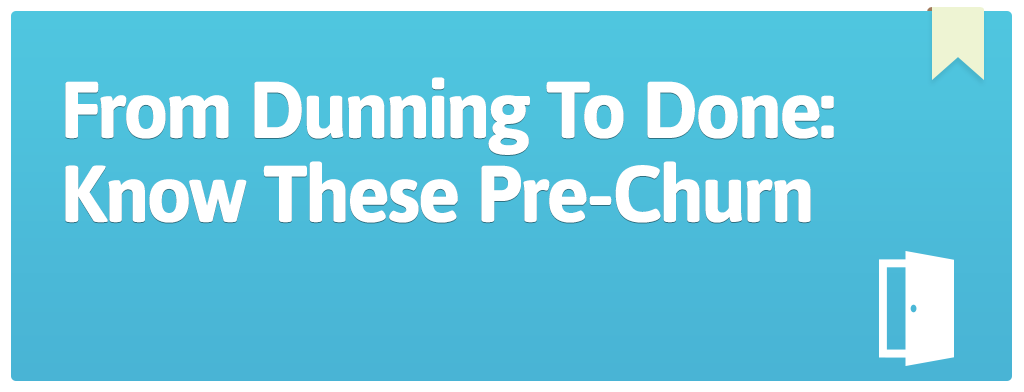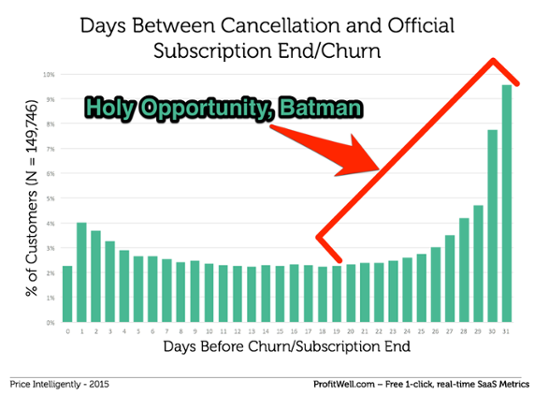
Customer churn is a critical measure for every SaaS.
We all would prefer to keep our customers and to that end, there’s an entire industry around doing a better job of retention (a major purpose of Stunning).
The whole idea is that you need to be proactive about reducing churn. It does no good to be the ambulance at the bottom of the cliff when when a customer is already long gone.
An important part of being proactive is knowing what to look for that may suggest a customer is readying to depart. What are the signs, and what can you be doing about them?
#1. Payment Issues
Part of the beauty of the SaaS subscription model is that you have monthly recurring revenue from each customer. You collect their payment details and your system automatically bills them at the same time every month.
This model also provides you with the opportunity to foresee and act upon any payment issues which could be a precursor to a cancelled account. For example, the customer may have a credit card on file that is about to expire or there may be some other reason a payment is prevented from being processed.
This is where dunning (and pre-dunning) come in. You can’t just ignore payment issues and hope the customer fixes them on their own. Much of the time, they may not even be aware of what is happening.
An application like Stunning can automatically process payment data in your system and send out notifications to customers before their credit card is due to expire, reminding them to update their details (pre-dunning). If payments are declined for any reason, the application can send out emails asking customers to update their information (dunning).
Much of the time, a customer is gone if you don’t get updated payment details early, so pre-dunning and dunning activities should be part of your overall monitoring process.
#2. Engagement
If a customer is engaged with your product, they are a lot less likely to silently cancel, but what does “engagement” actually look like?
As Lincoln Murphy puts it, may SaaS mistake activity for engagement, when the two aren’t really the same thing. For example, number of logins might be considered to be a good measure of “action”; however, does that mean the customer is really engaged with your product?
Engagement is where the customer derives value or customer success. This is going to look different depending on the individual client, but you can monitor for them achieving milestones with your product, such as creating a deliverable with it or integrating it with other software they use daily.
Yes, you absolutely should monitor for action too. If a customer isn’t logging in or is abandoning before completing processes in your application, the chances are good that they’re on the road out. You can stay on top of this by triggering emails for incomplete actions, reminding them that they haven’t logged in for a while and offering to help, or simply picking up the phone and giving them a call.
#3. Complaints & Help Tickets
The reason we monitor for the more subtle activities is that the customer often says absolutely nothing before cancelling their subscription. However, be sure not to miss the obvious, the ones who do seek help or make a complaint.
If a customer is complaining, or even expressing that they don’t understand how something works, they are effectively putting you on notice prior to cancelling. Don’t miss the opportunity to impress.
The second “s” in SaaS is service and your customers are seeking an appropriate experience. If you don’t deliver, hitting the cancel button is quite an easy action to take. Have documented standards for managing complaints and service requests and give the customer options.
Many SaaS seem to think that they’ve “got it covered” through having information in a knowledge base, but to a customer who is seeking a quick solution, the knowledge base can just be a cumbersome hold-up.
Have your knowledge base there for those who prefer it, but have some obvious other options too, such as filing a help ticket, filling out a webform or simply clicking on a live chat request.
A further strategy is to take a proactive approach when an issue or help item comes up. If it’s something that’s likely to be encountered by others, put out a piece of content and share it with your users. Again, you don’t know who else is having the same problem, but not saying anything about it.
#4. Customers Aren’t Getting What They’d Like
While any feature updates should be carefully assessed prior to implementing, a key consideration should be knowing what your customers actually want.
Are you surveying them? Are you calling them and asking them what they like and what they’d like to see as an improvement?
If there are feature requests that are coming up consistently but not being addressed, it’s probably only a matter of time before you lose customers to a competitor who is prepared to introduce that feature.
Most SaaS will find that some of their features are more important to customers and get more use than others. You should be monitoring exactly what those are and putting time into improving them, as well as looking into any new features which are a popular request.
#5. Optimizing For Retention
We all put a lot of focus into conversion optimization, but as pointed out by Tim Ash of Marketing Land, there is an opportunity sitting right in front of SaaS to optimize for retention.
This means putting time into understanding the user, because it’s those things you don’t know about them which can cause them to leave.
If you’re not segmenting your audience, presenting relevant information, fostering loyalty or making targeted, appropriate offers, the chances are you are not optimized for retaining clients.
#6. When A Customer Cancels
Andrew Tate makes a very valid point: are you tossing customers on the “churn pile” as soon as they hit the cancel button.
Cancelling is a very obvious statement saying “I’m leaving,” but as Tate points out, they haven’t actually churned yet (hence this goes onto the list of “pre-churn” signs).
What about those customers who cancel before their subscription period has actually ended? These represent a big opportunity to take action, before they lose their account access to your product.

Source: Paywell
Now is the time to make contact with those customers and find out exactly why they cancelled. Are the reasons something you can help them with? Can you provide a service experience which brings them back?
The other important piece here is to take note of their reasons and take action to improve what you can. It does no good to put work into bringing them back, but not fix whatever experience lead to them leaving in the first place.
Final Thoughts
Churn is a big issue for SaaS, so what you do in terms of pre-churn monitoring really counts.
This means being proactive about noticing the signs, from dunning to disengagement, that a customer is likely to churn and doing something about it.
Arguably, retention optimization is just as important, if not more so, than conversion optimization because it does tend to cost your business a lot more to bring on new clients, rather than keep the current ones.

